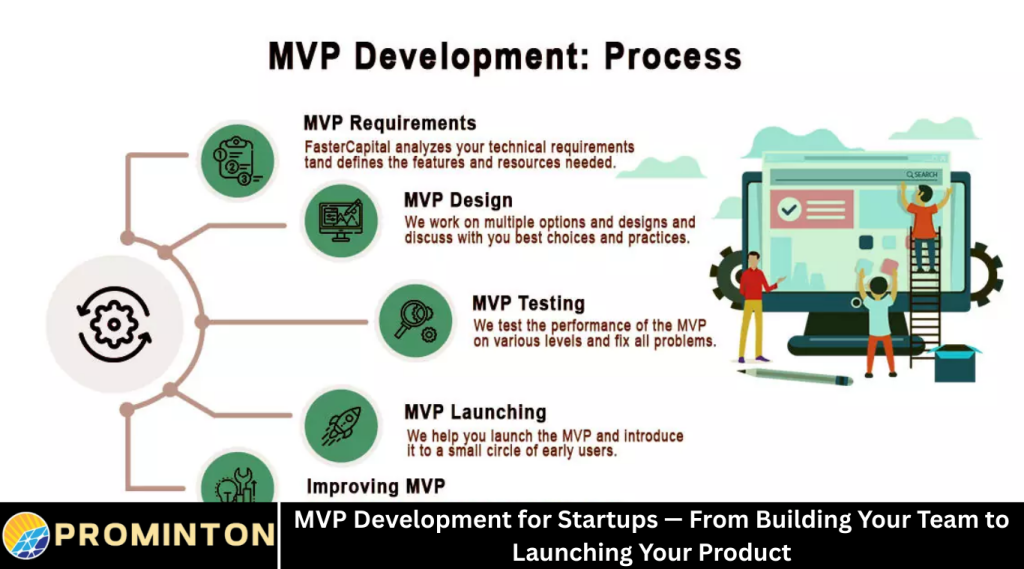For startups, launching a product that meets customer needs while minimizing time and cost is crucial. This is where the concept of a Minimum Viable Product, or MVP, comes into play. An MVP is a simplified version of a product that includes only the essential features needed to satisfy early users and gather feedback. Building an MVP helps startups validate their ideas, reduce risks, and prepare for full-scale development.
This article guides you through the entire MVP development journey—from assembling the right team, defining the product scope, designing and developing the MVP, to launching and iterating based on feedback. Whether you are a first-time founder or a startup enthusiast, this guide will help you understand the key steps and best practices to create a successful MVP.
Understanding the Concept of MVP
Before diving into development, it is important to understand what an MVP is and why it matters.
An MVP is not a half-finished product. Instead, it is a product version that delivers core value with the least amount of effort. The goal is to test the market and learn from real users quickly. This approach prevents spending large amounts of time and money on features that may not be needed or wanted.
Startups use MVPs to:
- Validate the product idea and market demand.
- Collect user feedback to improve the product.
- Attract early customers and investors.
- Identify technical challenges early on.
Building the Right Team for MVP Development
Successful MVP development starts with building a capable and motivated team. The team’s size and composition depend on your product complexity, budget, and timeline.
Founders and Product Owners
The founders or product owners provide the vision and direction for the MVP. They define the problem the product solves, outline key features, and ensure the team stays focused on user needs.
Designers
Designers play a critical role in creating an intuitive user experience. They develop wireframes, mockups, and prototypes to visualize the product before development begins. Good design helps reduce development errors and improves user satisfaction.
Developers
Developers bring the product to life by writing the code. Depending on the product, you may need front-end developers (for user interface), back-end developers (for server and database), or full-stack developers who handle both.
Quality Assurance Specialists
Quality assurance (QA) specialists test the MVP for bugs, usability issues, and performance problems. They ensure the product works smoothly before launch.
Marketing and Customer Support
Marketing professionals help prepare the MVP launch by building awareness and attracting users. Customer support teams assist early adopters and collect valuable feedback.
Defining the MVP Scope and Features
One of the biggest challenges in MVP development is deciding which features to include. It is essential to focus only on the core functionalities that solve the main problem for your target audience.
Identify the Target Audience and Their Needs
Understand who your users are and what problems they face. Conduct surveys, interviews, or research to gather insights.
Prioritize Features Based on Value
List all possible features and rank them by how much value they provide to users. Choose the minimum set of features that allow users to experience the product’s main benefit.
Avoid Feature Creep
Resist the temptation to add nice-to-have features during the MVP phase. Extra features can delay launch and dilute the focus on testing assumptions.
Designing the MVP
Designing your MVP involves creating clear, user-friendly interfaces that guide users to the product’s core functions without confusion.
Wireframes and Prototypes
Start with simple wireframes that outline the basic structure and flow. Move on to clickable prototypes that simulate user interactions.
User Experience (UX) Focus
Ensure the design is intuitive and accessible. A good UX reduces learning time and increases user retention.
Feedback Before Development
Share prototypes with potential users or stakeholders to gather early feedback and make necessary adjustments.
Developing the MVP
With a defined scope and design, the development phase begins.
Choose the Right Technology Stack
Select technologies that allow quick development and easy iteration. For startups, using popular frameworks and platforms with strong community support can speed up development.
Agile Development Approach
Use an agile methodology that promotes incremental development, frequent testing, and continuous feedback. This helps address issues early and adapt to changes.
Regular Testing
Incorporate quality assurance throughout development to catch bugs and usability problems. Early testing reduces costly fixes after launch.
Preparing for the MVP Launch
Launching your MVP is a critical moment that requires careful planning.
Develop a Launch Plan
Decide on your launch goals, target channels, and marketing strategies. Prepare promotional content such as blog posts, social media updates, and email campaigns.
Onboard Early Users
Identify early adopters who are likely to give honest feedback. This group might include friends, family, industry contacts, or niche communities.
Set Up Analytics and Feedback Systems
Integrate tools to track user behavior and collect feedback. This data will guide your next development steps.
Post-Launch: Iterating and Improving the Product
The MVP launch is not the end but the beginning of an ongoing process.
Analyze User Feedback
Review feedback and usage data to understand what works and what needs improvement.
Prioritize Updates
Based on insights, decide which features to add, modify, or remove. Focus on changes that improve user satisfaction and product viability.
Communicate with Users
Keep users informed about updates and listen to their suggestions. Building a community around your product helps maintain engagement.
Common Mistakes to Avoid in MVP Development
Avoiding common pitfalls can save time and resources.
- Building a product that is too complex or incomplete.
- Ignoring user feedback or delaying improvements.
- Overlooking marketing and user acquisition efforts.
- Hiring the wrong team members or lacking clear roles.
- Not defining clear goals for the MVP.
Frequently Asked Questions
What is an MVP?
A Minimum Viable Product (MVP) is a basic version of a product that includes only the essential features needed to satisfy early users and gather feedback.
Why is MVP development important for startups?
MVP development allows startups to test ideas quickly, reduce risks, and save resources by avoiding building unnecessary features.
How do you decide which features to include in an MVP?
Focus on the core features that solve the main problem for your target users. Prioritize based on value and avoid adding extra features early on.
Who should be part of the MVP development team?
An effective MVP team usually includes founders or product owners, designers, developers, quality assurance specialists, and marketing professionals.
How long does it typically take to build an MVP?
The timeline varies depending on complexity but generally ranges from a few weeks to a few months.
What happens after launching the MVP?
After launch, startups collect user feedback and usage data to improve the product through iterations and updates.
Can an MVP be changed after launch?
Yes, an MVP is meant to evolve based on real user insights. Continuous improvement is key to building a successful product.
Conclusion
Developing an MVP is a vital step for startups aiming to bring successful products to market efficiently. From assembling the right team to carefully selecting features, designing with the user in mind, and launching thoughtfully, every step matters.
The MVP helps validate your business idea, reduce risks, and create a foundation for future growth. Post-launch, continuous learning from users and adapting the product are essential for success.



